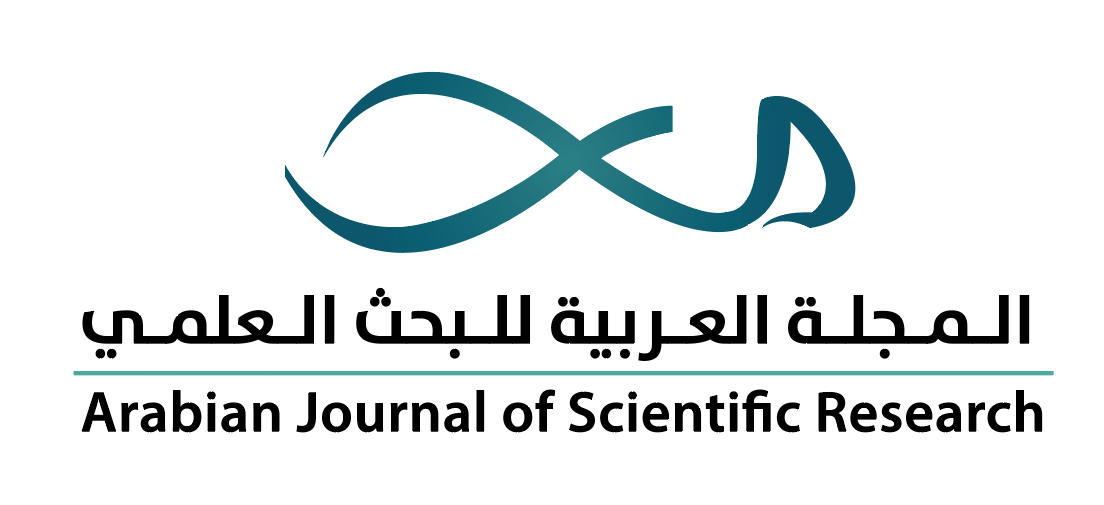-
oa تقدير فعالية إنزيم (nitrate reductase) باستخدام دقائق الفضة النانوية المخلقة حيويًا من الفطرين (Pleurotus pulmonarius) و(Pleurotus ostreatus var ostreatus) وتأثيرها على الفطر (Pythium aphanidermatum)
- Source: Arabian Journal of Scientific Research-المجلة العربية للبحث العلمي, Volume 2(2021), Issue 1, Jun 2021, 3
-
- 23 August 2020
- 18 January 2021
- 30 April 2021
Abstract
الملخص
أجريت هذه الدراسة في مختبرات قسم وقاية النبات بكلية الزراعة في جامعة تكريت خلال الموسم 2019/2018، بهدف دراسة فعالية إنزيم "اختزال النترات" (Nitrate reductase) باستخدام أربعة تراكيز (0.5 و1 و1.5 و2 ملي مول) من دقائق الفضة النانوية المخلقة حيويًا من الفطرين الغذائيين (Pleurotus Pulmonarius) و(Pleurotus ostreatus var ostreatus). لكل فطر أربعة أجزاء، هي راشح الفطر، والكتلة الحيوية، والمستخلص المائي الحار والبارد للكتلة الحيوية للفطر، ودراسة تأثير جسيمات الفضة النانوية على الفطر (Pythium aphanidermatum). أظهرت كافة تراكيز وأنواع جسيمات الفضة النانوية المحضرة أعلى فعالية لإنزيم (Nitrate reductase) مقارنة بمعاملة الشاهد (تركيز صفر) وهو ماء مقطر، وبلغت أعلى فعالية عند تركيز 1.5 ملي مول في رواشح الفطريات، إذ بلغت 0.65 و0.66 وحدة/ مل للفطرين (P. pulmonarius) و(P.ostreatus var ostreatus) تلتها المعاملة المؤلفة من المستخلص المائي البارد للتركيز نفسه، إذ بلغت 0.55 و0.56 وحدة/ مل، على التوالي، مع عدم وجود فروق معنوية بينهما. في حين أظهرت المعاملة المؤلفة من راشح الفطر فرقًا معنويًا مع باقي المعاملات، إذ بلغت أعلى فعالية إنزيمية للفطرين عند 0.32 و0.43 وحدة/ مل، على التوالي، مقارنة بمعاملة المستخلص المائي الحار التي أظهرت أدنى فعالية إنزيمية، فبلغت 0.11 و0.24 وحدة/ مل، على التوالي. كما أظهرت النتائج المختبرية عدم تسجيل فروق معنوية لتراكيز جسيمات الفضة النانوية في نسب انبات بذور القمح (صنف شام 6) لكافة تراكيز وانواع جسيمات الفضة النانوية المحضرة اذ بلغت اعلى نسبة انبات 97.38% لمعاملة الكتلة الحيوية للفطر P. pulmonarius فيما سجل الفطر P.ostreatus var ostreatus أعلى نسبة أنبات عند معاملة المستخلص المائي البارد اذ بلغت 97.20%.
This study was conducted in the laboratories of the Plant Protection Department, College of Agriculture at Tikrit University during the season 2018/2019. The study aimed at studying the effectiveness of nitrate reductase using four concentrations (0.5, 1.0, 1.5, and 2.0) mmol of biosynthetic silver nanoparticles created from the fungi Pleurotus pulmonarius and Pleurotus ostreatus var ostreatus. each fungus has four parts, including the filtrate of the fungus, the biomass, the hot and cold aqueous extract of the biomass of the fungus and its effect on Pythium aphanidermatum. All the concentrations and types of the prepared silver nanoparticles showed the highest efficacy of the nitrate reductase enzyme compared to the control. The highest activity was obtained at the concentration of 1.5 mmol in fungi filtrates, it was 0.65 and 0.66 units/ml for fungi p. pulmonarius and p.ostreatus var ostreatus, followed by the treatment consisting of cold aqueous extract of the same concentration which reached 0.55 and 0.56 units/ml, respectively with no significant differences between them. As for the treatment consisting of the fungus filtrate, this showed a significant difference with the rest of the treatments: The highest enzymatic activity of the fungi reached 0.32 and 0.43 units/ml respectively, compared with the treatment of hot water extract, which showed the lowest enzymatic activity, reaching 0.11 and 0.24 units/ml. The laboratory results did not show significant differences of silver nanoparticles in wheat seeds germination (Variety Sham6) for all concentrations and types of nanoparticles prepared. Whereas the highest germination percentage (97.38%) was for Pythium aphanidermatum biomass while P.ostreatus var ostreatus had highest germination percentage for cold aqueous extract which reached 97.20%.


